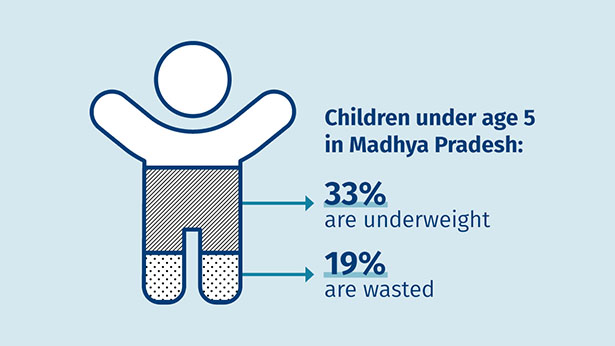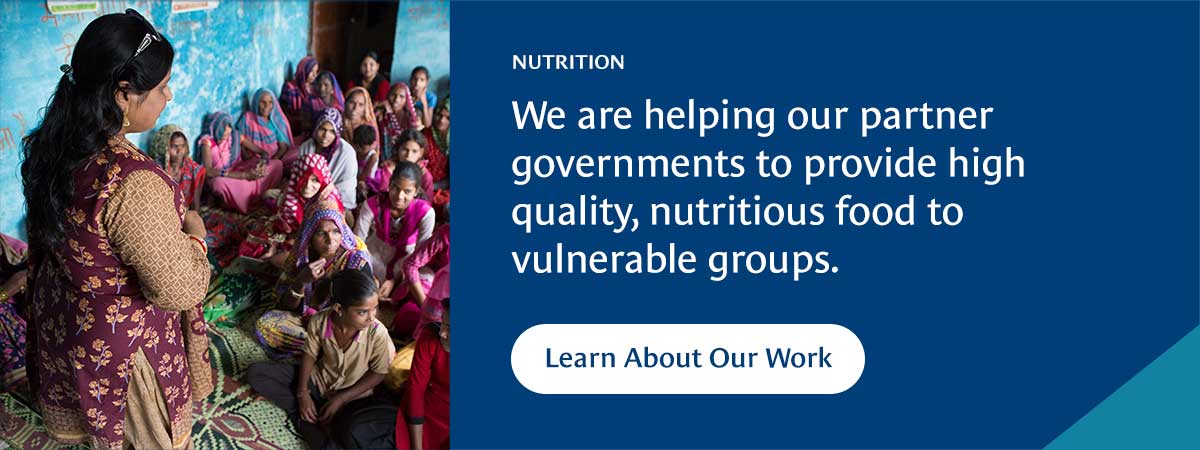How take-home-rations are facilitating a nutrition revolution in Madhya Pradesh
With her infant daughter in tow, Narmada walks down to the Anganwadi Center at the edge of her village in northern Madhya Pradesh (MP). It is a hot summer day and the girl, 18-month-old Meenu, has dozed off on her mother’s shoulders, as Narmada marches on with purpose.
As it turns out, she has significant cause for concern. For the past few months, Meenu hasn’t been as energetic and strong as other children her age. At an age of 18 months, she looks smaller and more fragile than the other children who were born around the same time as her. After a series of measurements and blood tests at the center, Narmada’s worst fears are confirmed. Meenu has been identified as severely malnourished, with signs of stunted development.
The bigger picture: Redefining nutrition
Despite the tremendous progress made in food production, India still accounts for a quarter of the world’s undernourished people.[1] Existing systems are unable to meet the minimum nutrition needs of a burgeoning population.

In MP— a heartland state with over 73 million people [2] ]— mothers give birth to underweight infants every day. According to recent national data, 33 percent of children under five in the state are underweight and 19 percent experience acute malnutrition [3].
These children grow up more likely to experience health issues, stunting of physical and mental faculties, and an intergenerational cycle of chronic malnutrition.
However, there has been some improvement in recent years. The Government of MP (GoMP) has made notable strides to ensure delivery of fortified supplementary food in the form of a Take-Home Ration (THR) to three key groups: children, adolescent girls, and pregnant and lactating women (PLW).
CHAI is supporting the GoMP in its efforts to improve g and integrate nutrition advocacy and programming and strengthen institutional capacities. The People-Powered Newtrition program is using a people-centric approach to transform nutrition in the state through programmatic, management, and institutional reforms.
Critical to reaching this goal is increasing access to the THR and reimagining its optimum utilization by leveraging the power of local systems and knowledge.
Hitting the sweet spot
The key ingredients of the THR, are wheat flour, soya flour, or rice. But once CHAI conducted assessments via label analyses and laboratory tests on Baal Aahaar (baby food), it was clear that some of the key micronutrients— equally critical for the physical and mental development of a child— were missing. Further, the sugar content in the baby food was as high as 25 percent and some packets also had unacceptable levels of yeast and mold.
Following detailed research, CHAI recommended changes in energy, protein, micronutrients, and fats by reformulating the following THR components:
- Diversifying protein sources, moving from wheat as the only source towards a blend of wheat, milk powder, and lentils.
- Reducing sugar levels that once accounted for 25 percent of the THR.
- Using only soybean oil or a blend of oils ensures the recommended balance of saturated to unsaturated fatty acids.
Baal Aahaar: A holistic and affordable outcome
Drawing from a thorough cost and community needs assessment, CHAI collaborated with the National Institute of Nutrition (NIN) who provided technical input on the recommendations for an improved THR formula meant for children (6-36 months), which boasted higher nutritional density and quality.
Not only did it have higher content and quality of protein-rich ingredients such as soy flour and milk powder, but the sugar content in the new recipe was also considerably lowered by 10 percent. This has been made possible by the centrally mandated increase in the budget for THR at the time.
The benefits are projected to be immense and lasting. The reduction of the sugar content, for instance, will ensure that the calorific value is mostly drawn from the primary ingredient, wheat. Modifications made to micronutrients will further increase the levels of iron, folic acid, and zinc through fortification to 100 percent of recommended daily allowance (RDA). Other critical micronutrients such as vitamins B6, B12, and D have also been added to the mix, at 50 percent of RDA, keeping the deficiency diseases associated with each of them in mind.
Most importantly, from the government’s perspective, it was of paramount importance that a higher nutritional impact could be achieved at a negligible cost of Rs. 2 (US$.03) per beneficiary per day, which was well within the government’s stipulated budget.
Replicating success
Devising considerations for rationalizing the recipes was also critical, especially to improve the palatability or shelf life, or reduce consumer pain points while cooking the recipe at home. As a result of the Atal Bihari Bajpayee Bal Arogya Avam Poshan Mission, the GoMP signed a memorandum of understanding (MoU) with CHAI for developing alternative recipes under the supplementary nutrition program, to optimize micronutrient and protein content within the requirements mandated by the Integrated Child Development Scheme (ICDS).
Over the years, CHAI’s work on the reformulation of THR in MP has been appreciated immensely. In 2018, Tata Trusts along with Pharos, a research group at the Harvard School of Business, published a policy brief that highlights CHAI’s work on recipe reformulation as a replicable best practice.
Driving uptake through community engagement
CHAI has also invested tremendous energy in improving uptake of THR through 150,000 frontline workers (FLWs), strengthening their capacity to counsel beneficiaries on good nutritional practices, dispel myths, also playing a vital role in raising awareness on THR and demonstrating how to prepare the formula.
To best explain this, we return to Narmada’s visit to the Anganwadi Center. We acknowledge the role that a local women’s self-help group played in encouraging her to make the trip. The community linkage continues as Narmada consults with the local Accredited Social Health Activist (ASHA) and the Anganwadi Worker (AWW) posted at the AWC, who checks Meenu’s height, weight, arm circumference, diagnoses her with severe acute malnutrition (SAM), and directs Narmada to put her on a THR diet. With the solution now within her reach, Narmada now prepares the THR every day, knowing that Meenu is getting all the essential proteins, vitamins, and minerals she needs.
Creating this enabling environment with responsive local institutions was also made possible by behavior change communication (BCC) tools, at community meetings like matru sabhas where young mothers met at the AWCs to discuss nutrition in their daily lives. Narmada’s visit to the center had coincided with one such session, where she met other women like her, who shared their experiences, discussed their problems as a group, taking home a lot more than rations.
Looking ahead
This people-centric approach to redefining nutrition belies People-Powered Newtrition, a transformative strategy that focuses on programmatic, management, and institutional reformations to close all nutritional gaps.
Under the aegis of People-Powered Newtrition, MP is certainly rewriting its nutritional future by focusing on the nutrition needs of children, who are a vital participant in the making of a country’s future and an important stakeholder in its economic development.
For MP, a largely malnourished state, the need is critical, and to ensure that the networks intended to produce and distribute nutrition are meeting the needs of those who need it the most. Today, due to the efforts put forth by CHAI, proactive community health workers and engaged communities have become the agents of change in the state. They are driving this progress and bringing CHAI’s innovative spins on existing solutions to life—proving that change can only come from within.
[1] 2018 Global Nutrition Report (GNR 2018)
[2] Census 2011
[3] Nation Family Health Survey (NFHS 5: 2019-2021)






